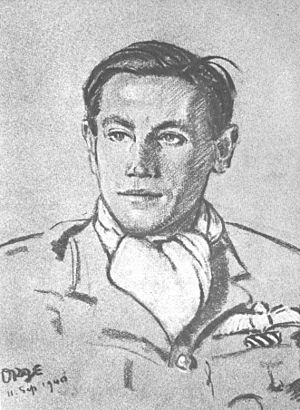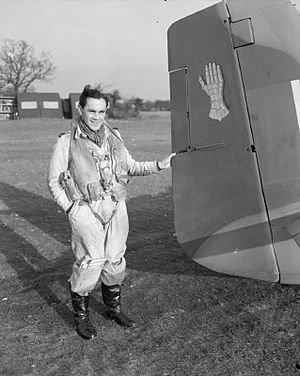Harold Bird-Wilson facts for kids
Quick facts for kids
Harold Arthur Cooper Cooper Bird-Wilson
|
|
|---|---|

Harold Bird-Wilson by Cuthbert Orde, 1940
|
|
| Nickname(s) | Birdie |
| Born | 20 November 1919 Prestatyn, Wales |
| Died | 27 December 2000 (aged 81) |
| Allegiance | United Kingdom |
| Service/ |
Royal Air Force |
| Years of service | 1937–1974 |
| Rank | Air Vice Marshal |
| Commands held | No. 23 Group (1970–73) RAF Hong Kong (1965–67) Central Flying School (1963–65) RAF Coltishall (1959–61) Air Fighting Development Squadron (1946–48) No. 66 Squadron RAF (1942–43) No. 152 Squadron RAF (1942) |
| Battles/wars | Second World War |
| Awards | Commander of the Order of the British Empire Distinguished Service Order Distinguished Flying Cross & Bar Air Force Cross & Bar Airman's Cross (Netherlands) Medal of Merit (Czechoslovakia) |
Air Vice Marshal Harold Arthur Cooper "Birdie" Bird-Wilson was a brave and skilled officer in the Royal Air Force. He was born on November 20, 1919, and passed away on December 27, 2000. During the Second World War, he became known as a "flying ace," meaning he shot down many enemy aircraft. He was also a member of the famous Guinea Pig Club, a group of pilots who received special medical care during the war.
Contents
Early Life
Harold Bird-Wilson was born in a town called Prestatyn in North Wales on November 20, 1919. His father worked as a tea-planter in India. Because his parents lived in India, Harold went to a boarding school in the UK. He later attended Liverpool College.
Becoming a Pilot
On November 30, 1937, Harold joined the RAF. He had a few weeks of basic officer training. Soon after, he began learning to fly fighter planes.
In August 1938, he joined No. 17 Squadron RAF. Here, he learned the basics of being a fighter pilot. He flew planes called Gloster Gauntlets. In June 1939, his squadron received newer planes, the Hawker Hurricanes.
Just ten weeks later, Harold was flying a BA Swallow plane. He crashed in bad weather near RAF Cranwell. Sadly, his passenger died in the crash. Harold was badly injured and lost his nose. He was treated by a very skilled plastic surgeon named Archibald McIndoe. Dr. McIndoe helped many injured RAF pilots during the war. Harold became part of the Guinea Pig Club. This club was for pilots who were treated by Dr. McIndoe.
Flying in World War II
In April 1940, Harold was back in action. He flew Hurricanes during the British retreat from France. This was a very difficult time for the RAF.
Harold was already a very good pilot. He was chosen to have his portrait drawn by Cuthbert Orde. These charcoal portraits were famous during the war. His portrait was drawn on September 11, 1940.
Shot Down but Not Out
On September 24, 1940, Harold was flying his Hurricane near Chatham, Kent. He was shot down by a famous German pilot named Adolf Galland. This was Galland's 40th enemy plane shot down. Harold's plane caught fire, but he managed to bail out. He landed in the River Thames and was rescued by a navy boat.
After this, he had to go to the hospital again. In 1941, he returned to service as an instructor. He taught other pilots at No. 56 Operational Training Unit. Later, he flew Spitfires with No. 234 Squadron RAF. He took part in raids over northern France. He even returned to command a unit at No. 56 OTU later that year.
Leading the Way
In 1942, Harold became the commander of No. 152 Squadron RAF. He also commanded No. 66 Squadron RAF. These squadrons led fighter planes that protected bombers. They flew on raids to the northern European coast. In 1943, he moved on to lead larger groups of planes called Wings.
In 1944, he went to the US for special command training. This was at Fort Leavenworth. After his training, he returned to action. He flew over Normandy Invasion during the D-Day landings.
The Jet Age
Harold ended the war commanding No. 1335 Jet Conversion Unit. This was the very first jet unit in the RAF. This shows how important he was in the development of new aircraft.
After the War
For many years after the war, Harold held various important jobs. He worked at the Central Flying Establishment. In 1946, he was put in charge of the air fighting development squadron. This unit helped improve how planes fought in the air.
In 1948, he moved to the Middle East. He became a personal staff officer to a very senior officer, Air Chief Marshal Sir John Baker.
Important Roles
In 1954, he joined the British Joint Services Mission in Washington, D.C.. He returned to the UK to be the Station Commander at RAF Coltishall. He held this role from June 1959 to November 1961. After that, he worked at the Air Ministry from 1961 to 1963.
He then spent two years commanding the Central Flying School. This school trains RAF pilots. He also spent two years as the air officer commanding RAF Hong Kong from 1965 to 1967. In 1967, he took a job at the Ministry of Technology.
From 1970 to March 1973, he commanded No. 23 Group RAF. This group was in charge of flying training for the RAF. His last job was commanding the Southern Maritime Air Region. He retired on June 1, 1974, at his own request. Harold Bird-Wilson passed away in 2000.
Family Life
Harold Bird-Wilson married Audrey Alma Wallace in 1942. They had a son named Robert in 1943. Their daughter, Carol, was born in 1945. Audrey passed away in 1991. Harold married again in 1994, to Margaret McGillivray Butler.


